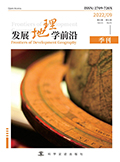

明确都市圈城镇化与生态系统服务之间的耦合与协同关系, 对推动都市圈城镇化高质量发展和维持生态平衡至关重要。本研究选取郑州都市圈为研究区域, 采用多源数据评估了该地区2000—2021年的城镇化水平, 测算了生态系统服务价值 (ESV) , 利用耦合协调度模型分析了城镇化与生态系统服务价值的时空耦合特征。结果表明: (1) 郑州都市圈的综合城镇化水平呈逐年上升趋势, 整体呈现出中西部高、东部低的分布格局, 区域间发展差异趋于缩小; (2) 研究期内, 保持土壤功能的ESV最大, 提供美学景观功能的ESV最小。空间分布上, 洛阳市各类功能的ESV均处于前列, 各地级市总体呈现东增西减、中部相对稳定的变化趋势; (3) 土地城镇化、经济城镇化与ESV变化具有较强的负相关性, 人口城镇化与ESV的相关性较小。城镇化与生态系统服务的耦合协调度整体呈上升趋势。
Clarifying the synergistic relationship between urbanization and ecosystem services in the metropolitan area is crucial for promoting high-quality urbanization and ecological conservation in the region. This study selects the Zhengzhou metropolitan area as the research region and employs multi-source data to measure and evaluate the level of urbanization and ecosystem service value (ESV) in this area from 2000 to 2021. The spatio-temporal coupling characteristics of urbanization and ecological services are analyzed using a coupling coordination degree model. The results indicate that: (1) The comprehensive urbanization level of the Zhengzhou metropolitan area exhibits an annual upward trend, with an overall distribution pattern of being higher in the central and western regions and lower in the eastern region, and the development differences among regions tend to narrow; (2) During the study period, the ESV of maintaining soil function was the largest and the ESV of providing aesthetic landscape function was the smallest. In terms of spatial distribution, Luoyang City ranks at the forefront in terms of the ESV of various functions, and the overall trend among prefecture-level cities is an increase in the east, a decrease in the west, with relative stability in the central region; (3) There is a strong negative correlation between land urbanization level, economic urbanization level, and ecosystem service functions, while the correlation between population urbanization level and ecosystem service functions is relatively small. The coupling coordination degree between urbanization and ecosystem services shows an overall upward trend.